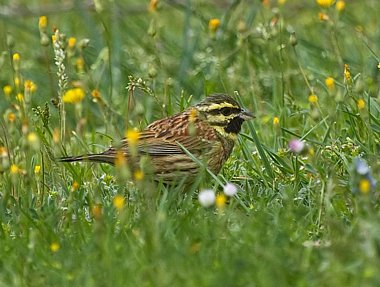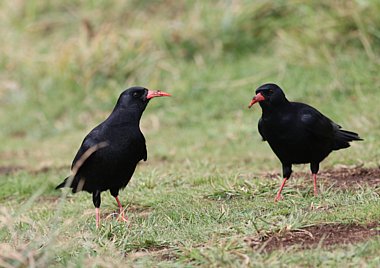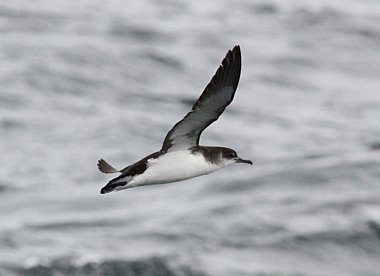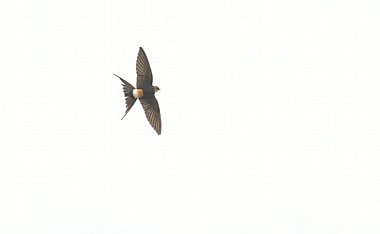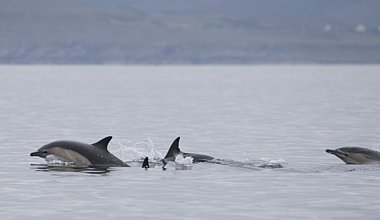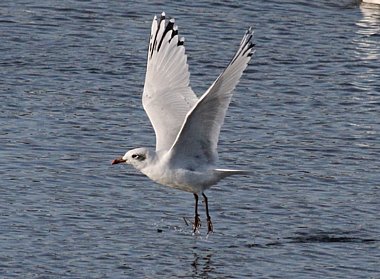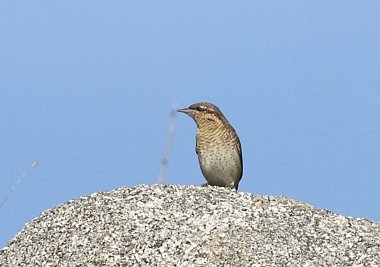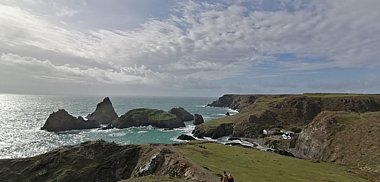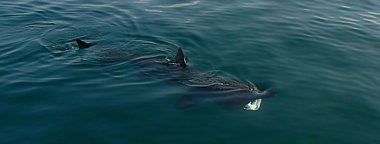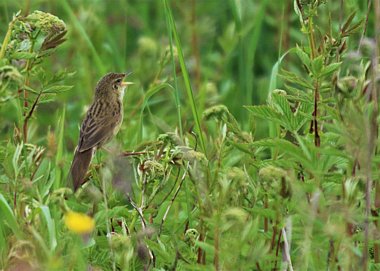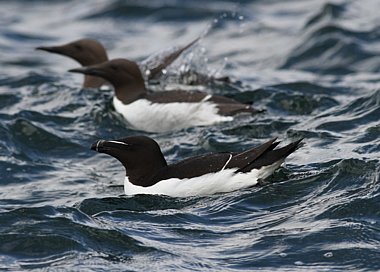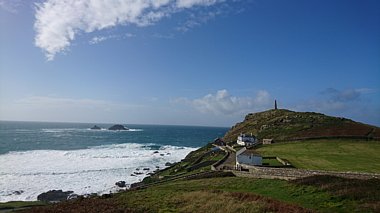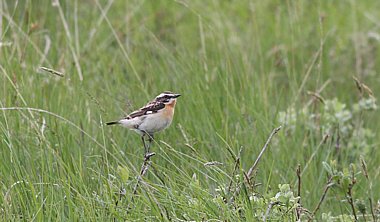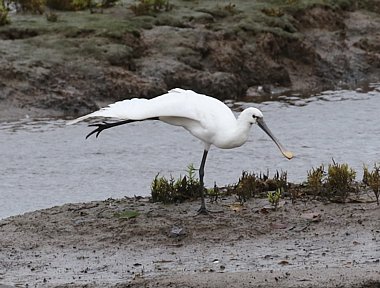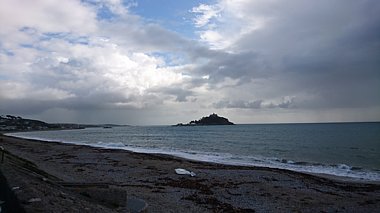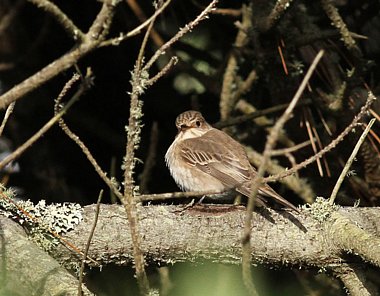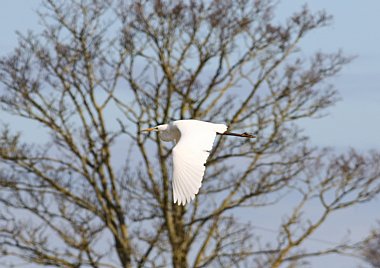Cornwall in Spring
Migrants and rare breeders on the beautiful Cornish coast
| Destination | |
|---|---|
| Focus | |
| 2026 Dates | |
| Duration | 8 Days |
| 2026 Price | £1995 pp £130 single supplement. Deposit £300 |
| Max Group Size | 7 |
Join us for great birding in Cornwall, one of the most under-watched counties in the UK! With over 400 miles of superb coastline, its steep cliffs, beautiful valleys and estuarine habitat all offer good birding. Based in Penwith in the far west, we explore a range of birding sites with northbound summer migrants high on our agenda. Seabirds, wildfowl, waders and passerines will feature, including a variety of warblers, flycatchers and chats to name but a few. If lucky we may connect with a rarity too, there are many possibilities depending on the prevailing weather.
Our daily schedule will be flexible, planning days around up to date local bird news and of course the weather. April is a great time to visit and extensive knowledge of all the birding hotspots and lesser known sites gives us a great chance to enjoy the county fully. Key sites include Marazion Marsh for wildfowl, Hayle for waders, gulls and more and Porthgwarra, arguably the most famous birding valley in the county! Land’s End might be a tourist attraction, but it is also a great birding location too. West Cornwall has a good track record for rarities in April with Night and Purple Heron, Black Kite, Montagu’s Harrier, Alpine Swift, Scops and Snowy Owl, Woodchat, Red-backed and Brown Shrike, Hoopoe, Golden Oriole, Short-toed Lark, Tawny and Red-throated Pipit, Western Subalpine, Melodious and Icterine Warbler, Ortolan and Little Bunting all recorded in recent springs!
A special feature of this spring holiday will be our search for Cirl Bunting. With a very small and range restricted population, this is a rare and difficult to see bird in the UK. The species is now breeding again in parts of southern Cornwall and we make a special effort to see them. We also visit the Lizard Peninsula where Chough famously first made their return and Dartford Warbler can be found. A boat trip into Mount’s Bay will give us good views of seabirds including Fulmar, Kittiwake, Manx Shearwater, Arctic Skua, auks and terns with Grey Seal, Common Dolphin, Harbour Porpoise and perhaps Basking Shark encountered.
Number of centres: 1.
Combine this holiday with our ‘Isles of Scilly in Spring’ tour.
Please note this holiday starts and ends in Penzance
We meet at Penzance station at 13:30, or at our accommodation at 14:00 if travelling by car. You can leave your vehicle parked here for the duration of your holiday. Please contact our office for travel tips by road, rail and air.
Day 1: Wed 16 April - Arrival, meet up and Marazion Marsh
Once settled into our comfortable accommodation, we head out for a few hours birding, with the RSPB reserve at Marazion Marsh an excellent place to start. A wetland site for wildfowl and waders, attractive Garganey pass through in April and we should see Little Egret, Snipe and Kingfisher on the pools too. Cetti’s Warbler are resident and a gentle walk through the reserve should give us other summer warblers, including recently arrived Reed and Sedge. Large numbers of Swallow and Sand Martin roost in the extensive reedbeds, so it comes as no surprise that Red-rumped Swallow is recorded annually. Other regular rarities include Purple Heron and Glossy Ibis while migrant Marsh Harrier and Hobby often find the reserve to their liking. Just across the road is Mount’s Bay with majestic St Michael’s Mount rising from the sea. The beach can be productive for waders and we can expect flocks of Ringed Plover, Dunlin, Turnstone and Sanderling along with lingering divers, grebes and seaduck offshore and after strong winds, skuas including Pomarine can be driven into the bay to shelter.
Day 2: Thurs 17 April – Porthgwarra and St Levan
Our first taste of ‘valley birding’ will be at Porthgwarra, arguably the most famous birding destination in the county being the most south-westerly point of Mainland Britain. A pretty place to explore, we seek out migrants, checking patches of trees and scrub for incoming northern breeders. Passing Cuckoo, Ring Ouzel, Wheatear, Whinchat, Redstart, Pied and Spotted Flycatchers, hirundines, pipits, finches, thrushes and a variety of warblers are all possible and in the right conditions numbers and diversity can be high. Regular Mediterranean scarcities include Hoopoe, Wryneck, Bee-eater, Woodchat Shrike, Western Subalpine Warbler and Serin - anything is possible! In the afternoon we plan to investigate other nearby valleys choosing from St Levan, Penberth or Porthcurno, or perhaps work the fields around Polgigga or Treen. A great day of exploratory birdwatching!
Day 3: Fri 18 April – Boat trip and Hayle Estuary
This morning we head to Penzance to take a special boat trip. As we meet our skipper and crew, we look out for the last few Purple Sandpiper among the Turnstones on the harbour wall before steaming out into Mount's Bay. Continuing west, we enjoy a different perspective of the attractive Penwith coastline and also the iconic open-air Minack Theatre. At St Clement’s Isle off of Mousehole, Grey Seal haul out, and it is worth searching the large numbers of gulls for scarce Yellow-legged, or indeed a late Iceland or Glaucous Gull. Gannet, Fulmar, Guillemot and Razorbill and Kittiwake should be plentiful, with Manx Shearwater and a few Puffin, Arctic Skua and terns likely to be around at this time of year. Cetaceans including Harbour Porpoise, Common and Bottlenose Dolphin are regular and impressive numbers of Basking Shark visit in April/May. Our exact course will be weather dependent, but we can anticipate being on the ocean wave for approximately three hours; a great trip!
Back on dry land we relocate to Hayle Estuary RSPB for the afternoon. The most important site for wildfowl and waders in the area, many thousands of birds feed on the tidal mud. Wigeon and Teal will be the most numerous wildfowl with Oystercatcher, Curlew, Bar-tailed Godwit, Dunlin, Knot and Redshank the commoner waders. Rarities are always possible and we should also see ever increasing Little Egret and Mediterranean Gull. With plenty of vantage points to view the estuary, we enjoy a busy afternoon, and if there is time to spare may visit nearby Porthkidney for terns or St Gothian Sands LNR to finish the day.
Day 4: Sat 19 April - Land’s End and Sennen
Land’s End might be a tourist attraction, but it is also one of the best birding locations in the UK! Isolated bushes and scrub are sparser than in the valleys, and it is also one of the best places for visible migration as birds arrive off the sea. Good paths allow for comfortable walking and in clifftop fields we should see pipits, Yellow and White Wagtail, Wheatear, Stonechat, Whinchat and Linnet. Vocal Chough often show well here as Raven, Peregrine and Kestrel patrol the skies above. Inland lies the village of Sennen, and more habitat and potential. Flocks of Lapwing, Golden Plover, Skylark and Meadow Pipit fill the fields, and our guides know quiet pools which will be worth checking for waders such as Green Sandpiper. The track record for rarities in the Land’s End/Sennen area is a strong one with Dotterel, Buff-breasted Sandpiper, Common Crane, Montagu’s Harrier, Wryneck, Woodchat, Red-backed and Brown Shrike, Hoopoe, Golden Oriole, Tawny and Red-throated Pipit, Eastern and Western Subalpine Warbler, Ortolan and Little Bunting all recorded in recent springs! After dinner, we may visit inland moors for any lingering Hen Harrier, Merlin or Short-eared Owl at dusk, perhaps seeing Barn or Tawny Owl on the drive home.
Day 5: Sun 20 April – Cirl Bunting
With a very small and range restricted population, Cirl Bunting is a rare and difficult to see bird in the UK. Formerly commonplace, thanks to RSPB re-introduction the species is now breeding again in parts of southern Cornwall and we make a special effort to see them. Other thriving farmland birds include Yellowhammer, Reed Bunting, Skylark, Linnet and Goldfinch. Searching for the Buntings will be our priority, but we should also have time for birdwatching around the Carrick Roads or could journey to Stithian’s Reservoir or the Tresillian River in the afternoon if good birds are reported there. A great day out to see a very rare UK resident!
Day 6: Mon 21 April – The Lizard
Today we visit the most southerly point in Britain and the area where Chough first returned in 2001, re-claiming their historic territories and featuring on the Cornish coat of arms. We should see this smart member of the crow family as we explore the sheltered valleys at Kynance, Caerthillian or Church Cove or in open ground at Lizard and Bass Points. The Lizard is one of the better places in Cornwall for Dartford Warbler and sites we visit hold similar migrant and rarity potential to those further west. Windmill Farm LNR, Croft Pascoe and farmland around the village also offer great birding and there can be lots to see in a relatively small area.
Day 7: Tues 22 April – St Just valleys, Pendeen and Drift.
The sheltered valleys next to St Just, a former mining town, give us another chance to seek out migrant passerines. Nanquidno, Cot, Kenidjack and Kelynack are all options, and we enjoy our time birding and walking in these beautiful areas. Drift Reservoir is the largest freshwater body in the area and time here is likely to add several new species including Great Crested and Little Grebe, Tufted Duck, Pochard, Greenshank, Common Sandpiper, Dipper and Grey Wagtail or even an Osprey. Being our last full day, we may decide to explore underwatched valleys and moors on the north Penwith coastline, or seawatch from Pendeen if winds are from a favourable direction.
Day 8: Wed 23 April - Final birding and departure
Our final morning and chance to mop up any species we might have missed or try a new birding site. Our exact plan will be dictated by travel arrangements, but we will be sure to get in as much birding as possible before concluding our holiday in Penzance.
Please note: all itineraries are given as a guide only. Actual holiday content may vary according to the judgement of your guide, and elements beyond our control (eg weather).
What's included in your 'Cornwall in Spring' holiday price
- Seven nights comfortable en-suite hotel accommodation. Guests are never expected to share. All rooms are en-suite. Full details with your joining pack.
- Full breakfast and dinner from Thursday evening until Thursday morning, packed lunch daily.
- A wildlife boat trip.
- Guidance from a professional Group Leader.
What's not included in your 'Cornwall in Spring' holiday price
- Travel to Penzance
- Insurance, drinks and other items of a personal nature.
Other Holiday Information:
Expect a wide variation in weather conditions. We may experience some warm weather, but Cornwall can be equally wet and windy. Sunshine, rain and strong winds are all possible, and you will probably experience a bit of everything. Please bring walking boots or shoes, weatherproof clothing and a small rucksack.
We are often on our feet for most of the day on this holiday. We take things at a slow pace, though will cover quite a few miles of walking over rough or uneven coastal paths and through fields or across sandy beaches each day. Our excursions are usually on good trails, though rare birds are often found in inconvenient locations, involving several gates and stiles to be climbed or long walks in exposed locations, often peering down gullies and into ditches. Please note that although there is a vehicle on this tour a reasonable level of fitness is required. You may find a walking pole useful!
Other birding and wildlife holidays in Southern England
- Isles of Scilly for birders
- Forest of Dean and Somerset Levels
- Isles of Scilly in Spring
- NEW! Winter Birdlife of Devon & Dorset
- West Cornwall in Autumn for birders
Why choose Heatherlea for your birding and wildlife holiday?
Heatherlea is one of Britain's leading wildlife holiday operators. In 2019 we celebrate our 29th Anniversary with more choice than ever, both in Scotland and overseas. Relax and enjoy yourself, as we do all the planning! Above all, we make it our business to show key wildlife to you. Our fully inclusive guided holidays concentrate on the real experience, and we take time to ensure that each of our guests enjoys everything we do.
- We have been organising birding and wildlife holidays for 30 seasons, and have a highly experienced and capable office team. We also offer a telephone and email service outside normal office hours.
- We are a small company, run BY birders FOR birders. Come and see!
- Heatherlea are Mainland Scotland’s FIRST ‘5-Star Wildlife Experience!’ This is the highest available grading, classified as ‘exceptional’ by visitScotland.
- Heatherlea hold full Tour Operator Insurance for your added protection.
- Heatherlea is a limited company, registered in Scotland. We are also registered to pay VAT, which is included in your holiday price as quoted on this page.
- Once your holiday is confirmed in writing by us, we promise not to surcharge the price for any reason.

